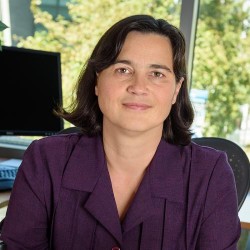$5 MILLION NSF GRANT SUPPORTS DATA-FRIENDLY RESEARCH PLATFORM

The San Diego Supercomputer Center (SDSC) has received a $5 million grant from the National Science Foundation’s Office of Advanced Cyberinfrastructure to prototype the National Research Platform (NRP), an actual information superhighway. Several members of the UC San Diego Computer Science and Engineering Department will lend their expertise to the project.
The grant funds efforts at SDSC, the Massachusetts Green High Performance Computing Center and the University of Nebraska–Lincoln to build a high-performance platform, optimizing equipment, configurations and security to support data-intensive science projects. The NRP will give research collaborators new opportunities to share data and work simultaneously on complex projects.
COVID Analysis
One of the many beneficiaries will be UC San Diego Computer Science and Engineering Professor Tajana Rosing, who is trying to solve several high-data problems.
“I have been working with a couple of different teams on biology-related applications,” said Rosing. “For example, we’re trying to accelerate the COVID 19 genomics pipeline, creating a phylogenetic tree of life of all the different mutations of COVID-19 to track viral evolution. Right now, that takes a really long time.”
Working with Professor of Pediatrics and Computer Science and Engineering Rob Knight and Assistant Teaching Professor Niema Moshiri and others, Rosing is using programmable hardware, called field-programmable gate arrays (FPGAs), to accelerate the process. So far, the analysis pipeline works great until the last step, actually creating the phylogenetic tree. That’s where the NRP comes in.
“We will need many FPGAs to run in parallel, and that’s what the NRP platform does for us,” said Rosing. “The FPGAs must be connected with high bandwidth and low latency because we’re moving a lot of data around.”
Molecular Dynamics
Rosing is also using the NRP on a collaboration with the Lawrence Livermore Laboratory to model molecular dynamics to enhance drug discovery. The team is trying to analyze the physical movements of atoms and molecules, another data-intensive task, and using a similar parallel FPGA setup to gain the necessary speed.
“It’s massive amounts of data and it’s interactive data,” said Rosing. “We’re trying to simulate interactions that happen in femtoseconds (one quadrillionth of a second), and need this very parallel system to get there.”
The end goal is to use this computer modeling to determine which molecules have the greatest potential to become medicines. While chemists can create a seemingly endless number of molecules, only a few go on to become safe and effective therapies. Physically testing these molecules is both time-consuming and expensive.
“The nice thing about simulating these interactions in the computer is that we don’t have to run cell-based tests in the lab on every compound,” said Rosing. “We can use the model to weed out the ones that won’t work and only move forward with the ones that show promise, dramatically reducing the amount of time it takes to develop new medicines.”
